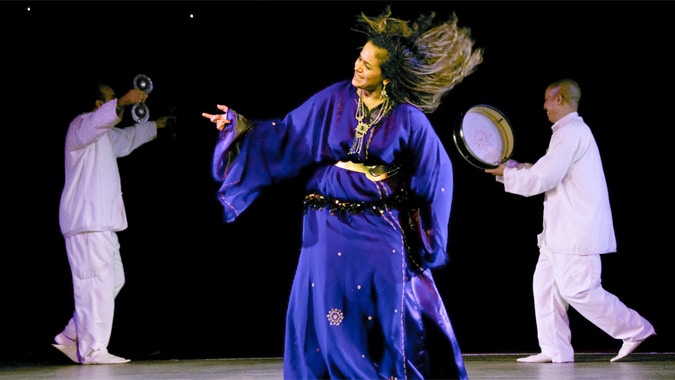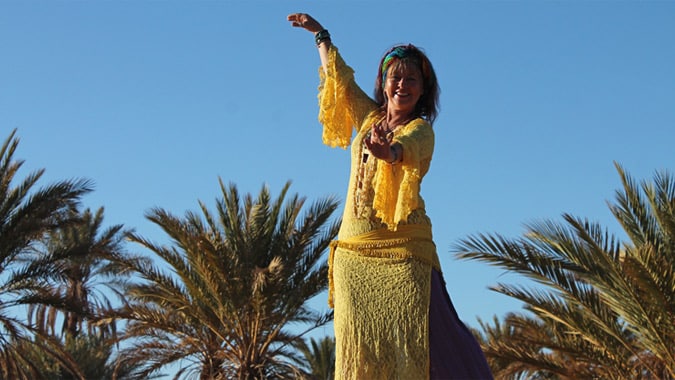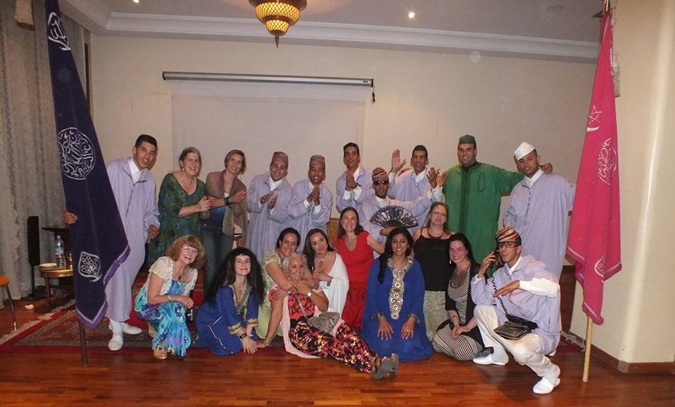What is Moroccan Shikhat Dance
Last Updated on January 29, 2024

What is Shikhat Dance?
Shikhat is the name given in Morocco to the performers of this type of dance. In standard Arabic Shikha means ‘the wise one’ and shikhat is the plural for shikha.
According to some, this name is due to the fact that shikhat are considered ‘women of the world’, experienced people who are usually invited to perform in rituals and celebrations in Morocco.
However, in the Moroccan Darija dialect, Schikkatt are singers/performers/entertainers who sing about life, love, sadness, nostalgia all aspects of life, so nothing to do with wisdom.
Shikat are essential in traditional Moroccan wedding celebrations and other festivities.
According to some sources, in particular, the book ‘You asked Aunt Rocky: Answers & Advice About Raqs Sharqi and Raqs Shaabi’, on pages 24 to 28, by the American dancer Morocco (Carolina Varga Dinucu), their pelvic movements are supposed to be a sort of ‘sexual education’ for the young bride.
However, according to the Moroccan dancer Nawarra (based in Leeds, UK), who has an MBA in arts and drama and studied in Casablanca University with local professors and with great singers like Hajib, Schikkatt’s movements have nothing to do with sexual education.
In fact, their hip movements are rooted in African dance tradition, so they are just dance movements like any other with no reference to sexual education.
The Role of the Shikha
Deborah A. Kapchan, Associate Professor of Performance Studies in the Tisch School of the Arts in New York University, has written an insightful article about Moroccan Shikhat (Kapchan, 1994).
She spent time in Morocco and she interviewed several shikhat, to understand their role in Moroccan society and how this reflects the attitude towards women in that country.
According to Kapchan, Shikhat, in Moroccan society, are central to celebrations and part of the national culture but their role is an ambivalent one.
They usually come from a poor background and they are often independent women, who earn their own living through their art and they are often unmarried.
In a conservative society, this means that they are seen with suspicion.
Shikhat mix socially with men, smoke, and drink, all things that are considered unacceptable for women in traditional Moroccan circles.
The middle classes in big cities now are more accepting of women working outside the house, socializing with men, and smoking.
However, in addition to this, shikhat dance in public for money, which contributes largely to attracting a stigma on them.
Kapchan, towards the end of her article, tells us how the most successful shikhat has ‘redeemed’ themselves in the eye of society through the use of technology.
The best shikhat have recorded their performances on video, which has raised their profile as it has helped highlight the artistic and cultural value of their dance.
This has resulted in improving their financial situations and also in making the government aware of the role of shikhat as part of Moroccan cultural heritage.
Nowadays, while the attitude towards shikhat is still ambivalent, they are also seen as embodiments of Moroccan culture and their dance is often displayed at cultural events and for tourists.
In the video above, you can see an example of shikhat dance.
Shikhat Dance Movements
There are different styles of Shikhat dance, according to the different regions of Morocco.
However, this dance genre is generally characterized by fast and energetic hip movements, belly drops, shimmies, and rotations of the head that let the dancers’ long hair flow freely.
Shikat usually perform in small groups of three or four and they are usually accompanied by a singer (male or female, but often the shikhat herself sings) and musicians (often male) who play Moroccan traditional instruments, including drums and violins (kemanjeh).
Some shikhat play finger cymbals, called mooukas, while dancing, or a tambourine called taarija.
The dancers sometimes dance together and sometimes alternate each other in solo performances. In the solo part, the dance starts slowly but it then increases in intensity, with isolated movements of the hips that go faster and faster and bouncy little steps.
Dancers never dance on the balls of their feet, but on flat feet with rather shuffling steps.
At some point, the dancer will start spinning on herself at times and also rotating her head, in order to let her long hair move freely.
These hair moves are done to enhance the trance mood because, according to Nawarra, all Moroccan dance styles are trance dances.
There is some floor work involved as the dancer kneels on the ground, while still moving her head up and down and side to side.
Shikhat Costumes
Shikhat usually wears long caftans, with long bell-shaped sleeves and embroidery and a belt around their waist.
The styles change across Morocco, but this is the basic feature. Also, dancers wear a hip belt around their hips.
A thick but not wide belt, usually made of threaded wool with incorporated sequins.
Also, dancers wear jewelry, which can be more or less elaborated.
Where You Can Learn Shikhat
There are not many dance teachers I know who teach shikhat outside Morocco but, if you know of someone, please do post your comments below.
The two dancers I know of, who teach and perform shikhat outside Morocco, are:
Aunty Rocky
Morocco, also called Aunty Rocky (Carolina Varga Dinicu), is based in New York. She has been involved in Middle Eastern and Northern African dance for at least 50 years and she has traveled extensively across those regions.
Hence, she knows a lot about the history and traditions of these dance forms, including Moroccan dances.
She teaches regular classes in New York and travels around the world teaching in workshops in different types of dance.
I attended one of her shikhat workshops in Glastonbury (UK), at the Majma Festival.
You can read here an interesting article she has written about Moroccan dances.
Morocco has also written a book, entitled ‘You asked Aunt Rocky: Answers & Advice About Raqs Sharqi and Raqs Shaabi’, where, on pages 24 to 28, you can read more information about shikhat.
Nawarra
Nawarra is a dancer originally from Casablanca in Morocco, now living and teaching in Leeds, UK.
She performs and teaches different genres of Middle Eastern and Northern African dances, including Raqs sharqi, Egyptian Shaabi and Saiidi, and, of course, Moroccan shikhat.
I have seen her perform shikhat at various festivals in the UK and she is an incredible dancer.
Her performance was very energetic, filled with feeling, and a great sense of fun.
Trips to Morocco

Anne Kingston
Another dance teacher from the UK who organizes trips to Morocco for dancers is Anne Kingston.
Her trips are not about teaching shikhat, rather more about healing and experiencing the desert (an amazing experience in itself), there is some dance involved, albeit not shikhat.
Her trips include African/Middle Eastern dance, African drumming, Shamanic Reiki healing, Sound healing, camel riding, Berber culture, camp-fires, star watching, and are located in the Sahara desert in Morocco near M’Hamid.
They travel from Marrakech through the Atlas Mountains and down the beautiful Draa Valley to their desert home and then back to Marrakech at the end of the trip for souk shopping, hammam, and a traditional belly dance show.
Bookings and Further information on Desert Dance Healing Facebook page on her website www.annekingston.com

Nawarra

Nawarra has been organizing trips to Morocco for dancers for over 14 years at the moment of writing.
She was granted the Guide Tour badge by the Moroccan Tourism Ministry in 2011, so she is an official tour guide.
Nawarra’s trips include teaching shikhat but they are not limited to it as they are aimed at making participants experience as much as possible of the Moroccan culture.
Nawarra teaches other types of Moroccan traditional dances as well.
She has recently started a pure folkloric dance camp in Morocco, which had about 30 participants, including Shira and Saqra from the USA (well-known figures in the belly dance scene).
Nawarra’s trips are ideal for those who want to discover the fascinating country of Morocco and its dance and cultural traditions.
I have been to one of her trips, the Funoon Dance Camp, and I thoroughly enjoyed it.
It was a week packed with dance, entertainment, culture, and fun. You can read more in detail about my experience in Fez by clicking here.
For information on her upcoming trips, you can find Nawarra on Facebook under the name ‘Nawarra dancer’.
References
- More on Moroccan Shikhat heritage.
- Kapchan, D. A. (1994). “Moroccan Female Performers Defining the Social Body.” The Journal of American Folklore 107(423): 82-105.
Latest posts by Dr Valeria Lo Iacono (see all)
- Belly Dancing over the Age of 40, 50 and Beyond - February 1, 2025
- Health Benefits of Belly Dance - January 20, 2024
- 10 Countries for Learning Belly Dance - January 18, 2024














